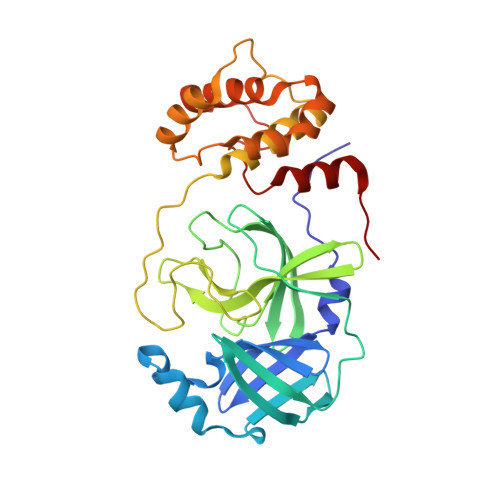Unusual zwitterionic catalytic site of SARS-CoV-2 main protease revealed by neutron crystallography.
Kneller, D.W., Phillips, G., Weiss, K.L., Pant, S., Zhang, Q., O'Neill, H.M., Coates, L., Kovalevsky, A.(2020) J Biol Chem 295: 17365-17373
- PubMed: 33060199
- DOI: https://doi.org/10.1074/jbc.AC120.016154
- Primary Citation of Related Structures:
7JUN - PubMed Abstract:
The main protease (3CL M pro ) from SARS-CoV-2, the etiological agent of COVID-19, is an essential enzyme for viral replication. 3CL M pro possesses an unusual catalytic dyad composed of Cys 145 and His 41 residues. A critical question in the field has been what the protonation states of the ionizable residues in the substrate-binding active-site cavity are; resolving this point would help understand the catalytic details of the enzyme and inform rational drug development against this pernicious virus. Here, we present the room-temperature neutron structure of 3CL M pro , which allowed direct determination of hydrogen atom positions and, hence, protonation states in the protease. We observe that the catalytic site natively adopts a zwitterionic reactive form in which Cys 145 is in the negatively charged thiolate state and His 41 is doubly protonated and positively charged, instead of the neutral unreactive state usually envisaged. The neutron structure also identified the protonation states, and thus electrical charges, of all other amino acid residues and revealed intricate hydrogen-bonding networks in the active-site cavity and at the dimer interface. The fine atomic details present in this structure were made possible by the unique scattering properties of the neutron, which is an ideal probe for locating hydrogen positions and experimentally determining protonation states at near-physiological temperature. Our observations provide critical information for structure-assisted and computational drug design, allowing precise tailoring of inhibitors to the enzyme's electrostatic environment.
Organizational Affiliation:
Neutron Scattering Division, Oak Ridge National Laboratory, Oak Ridge, Tennessee, USA; National Virtual Biotechnology Laboratory, United States Department of Energy, Washington, DC, USA.














